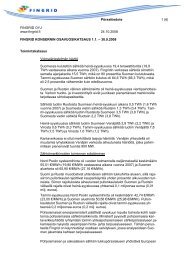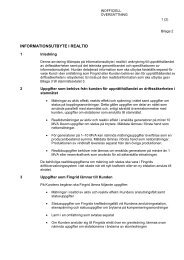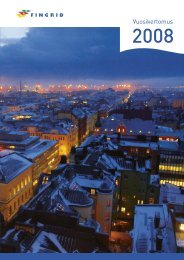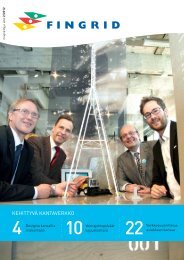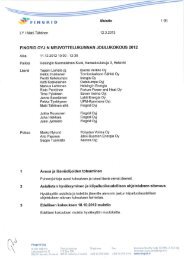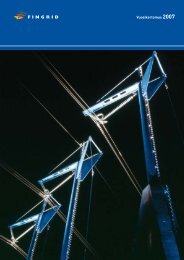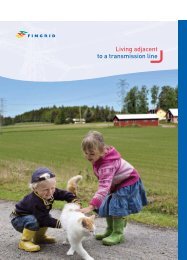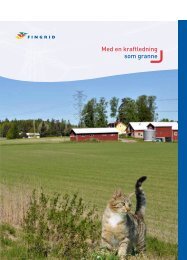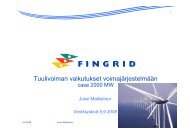3/2012 - Fingrid
3/2012 - Fingrid
3/2012 - Fingrid
You also want an ePaper? Increase the reach of your titles
YUMPU automatically turns print PDFs into web optimized ePapers that Google loves.
Network codes coming<br />
– what will change in system operation?<br />
ENTSO-E, the European Network of Transmission System Operators for Electricity, has been<br />
working on new network codes for transmission system operation. The goal is that all three relevant<br />
network codes would be ready within ENTSO-E at the latest by mid-2013.<br />
Text by Timo Kaukonen<br />
The Operational Security Network<br />
Code is one of the network<br />
codes which govern transmission<br />
system operation. This code which is<br />
being prepared right now defines the<br />
general principles and responsibilities<br />
as regards the maintained system security<br />
of the power system and relevant<br />
processes. The code aims to improve in<br />
particular co-ordination and co-operation<br />
between the transmission system<br />
operators (TSOs) in the management of<br />
cross-border transmissions and performance<br />
of cross-border interconnectors<br />
as well as in congestion management.<br />
The Operational Security Network<br />
Code will set the high-level requirements<br />
for system operation as a whole.<br />
The code is based on the (N-1) principle<br />
which provides for the most severe<br />
single failure at any given moment. The<br />
following categories of requirements<br />
have been established in the most recent<br />
Operational Security Network Code<br />
published on 17 August:<br />
• System states<br />
• Frequency control management<br />
• Voltage control and reactive power<br />
management<br />
• Short-circuit current management<br />
• Congestion and power flows<br />
management<br />
• Contingency analysis and handling<br />
• Protection<br />
• Dynamic stability assessment<br />
• Operational testing, monitoring and<br />
investigation<br />
• Data exchange<br />
• Operational training and<br />
certification<br />
The drawing up of the network code on<br />
Operational Planning and Scheduling<br />
is also in progress. This code specifies<br />
FINGRID 3/<strong>2012</strong> | 26<br />
the more detailed requirements for issues<br />
such as common grid models, operational<br />
security analyses and outage<br />
co-ordination, including their planning<br />
and scheduling. This network code<br />
will be in public consultation for two<br />
months from the beginning of November,<br />
during which time stakeholders can<br />
comment on it via ENTSO-E’s website.<br />
The third network code under preparation<br />
is called Load Frequency Control<br />
and Reserves. This network code<br />
has a direct impact on system operation,<br />
and it sets out in more detail the<br />
hierarchical structure of frequency control<br />
as well as the technical and volume<br />
requirements concerning the different<br />
types of reserves used in frequency<br />
control. The network code requires<br />
the TSOs to monitor frequency quality<br />
more accurately and to take necessary<br />
action if the frequency quality is not at<br />
a satisfactory level. The Load Frequency<br />
Framework Guideline<br />
• ACER prepares<br />
Network Code<br />
• ENTSO-E prepares<br />
• statutory regulations<br />
Control and Reserves network code also<br />
specifies the operational security conditions<br />
for the trade and distribution of<br />
reserves between TSOs and synchronous<br />
areas.<br />
Increasingly closer exchange<br />
of information<br />
In general, the network codes will call<br />
for more precise and better operational<br />
planning and real-time monitoring,<br />
which brings with it a need to increase<br />
the exchange of information between<br />
the TSOs, distribution network companies,<br />
and parties having a significant<br />
impact on the operation of cross-border<br />
transmission lines. In order to improve<br />
the real-time exchange of information<br />
between the TSOs, a shared data system,<br />
European Awareness System (EAS)<br />
is already underway. It will enable the<br />
control centres of other TSOs to obtain<br />
PREPARATORY PROCESS FOR EUROPEAN NETWORK CODES<br />
(Comitology) Guideline<br />
• Commission prepares<br />
• statutory regulations<br />
Comitology Committee<br />
• member states as the<br />
members<br />
• accepts the network codes<br />
and guidelines<br />
ACER Agency for the Cooperation of Energy Regulators<br />
ENTSO-E European Network of Transmission System Operators for Electricity<br />
The network codes will be drawn up in accordance with the EU’s third legislative<br />
package on the electricity market by following the policies and framework<br />
guidelines specified by the European Commission and ACER, Agency<br />
for the Cooperation of Energy Regulators. Following the approval of the<br />
European Parliament and official release, the network codes will represent<br />
legislation binding all member states.



